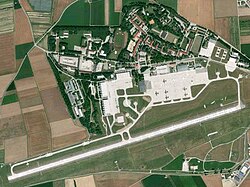
Williams Air Force Base is a former United States Air Force (USAF) base, located in Maricopa County, Arizona, east of Chandler, and about 30 miles (48 km) southeast of Phoenix. It is a designated Superfund site due to a number of soil and groundwater contaminants.

The German Air Force is the aerial warfare branch of the Bundeswehr, the armed forces of Germany. The German Air Force was founded in 1956 during the era of the Cold War as the aerial warfare branch of the armed forces of West Germany. After the reunification of West and East Germany in 1990, it integrated parts of the air force of the former German Democratic Republic, which itself had been founded in 1956 as part of the National People's Army. There is no organizational continuity between the current German Air Force and the former Luftwaffe of the Wehrmacht founded in 1935, which was completely disbanded in 1945/46 after World War II. The term Luftwaffe that is used for both the historic and the current German air force is the German-language generic designation of any air force.
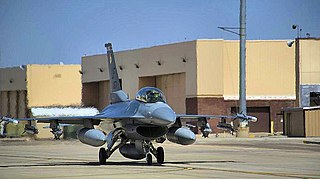
Holloman Air Force Base is a United States Air Force base established in 1942 located six miles (10 km) southwest of the central business district of Alamogordo, and a census-designated place in Otero County, New Mexico, United States. The base was named in honor of Col. George V. Holloman, a pioneer in guided missile research. It is the home of the 49th Wing of the Air Education and Training Command (AETC).

An aggressor squadron or adversary squadron is a squadron that is trained to act as an opposing force in military wargames. Aggressor squadrons use enemy tactics, techniques, and procedures to give a realistic simulation of air combat. Since it is impractical to use actual enemy aircraft and equipment, surrogate aircraft are used to emulate potential adversaries.

Sheppard Air Force Base is a United States Air Force (USAF) base located five miles (8.0 km) north of the central business district of Wichita Falls, in Wichita County, Texas, United States. It is the largest training base and most diversified in Air Education and Training Command. The base is named in honor of Texas Senator John Morris Sheppard, a supporter of military preparations before World War II.

Luke Air Force Base is a United States Air Force base in Maricopa County, Arizona, United States. It is located 7 miles west of the central business district of Glendale, and 15 miles west of Phoenix.

Vance Air Force Base is a United States Air Force base located in southern Enid, Oklahoma, about 65 mi (105 km) north northwest of Oklahoma City. The base is named after local World War II hero and Medal of Honor recipient, Lieutenant Colonel Leon Robert Vance Jr.

Air Training Command (ATC) is a former United States Air Force (USAF) Major Command designation. It was headquartered at Randolph Air Force Base, Texas, but was initially formed at Barksdale Air Force Base, Louisiana. It was re-designated as Air Education and Training Command (AETC) following a merger with Air University (AU) on 1 July 1993.

George Air Force Base was a United States Air Force base located within the city limits, 8 miles northwest, of central Victorville, California, about 75 miles northeast of Los Angeles, California.

Fürstenfeldbruck Air Base is a former German Air Force airfield near the town of Fürstenfeldbruck in Bavaria, near Munich, Germany.

Erding Air Base is a German Air Force airfield near the town of Erding, about 45 kilometers (28 mi) northeast of central Munich in Bavaria. It is the home of the 5th Air Defense Missile Squadron and the 1st Air Force Maintenance Regiment.

The 178th Wing is a unit of the Ohio Air National Guard, stationed at the Springfield-Beckley Municipal Airport ANG complex, Springfield, Ohio. If activated to federal service, the wing is gained by the United States Air Force Air Combat Command (ACC), with elements of the wing gained by the Air Force Intelligence, Surveillance and Reconnaissance Agency (AFISRA).

The 20th Fighter Squadron is an inactive United States Air Force (USAF) squadron. It was most recently part of the 49th Fighter Wing at Holloman Air Force Base, New Mexico, where it operated the McDonnell F-4 Phantom II aircraft, conducting training and air superiority missions. It was inactivated on 20 December 2004.
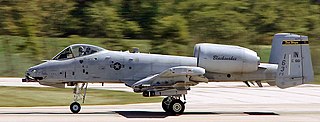
The 163rd Fighter Squadron is a unit of the Indiana Air National Guard's 122nd Fighter Wing, located at Fort Wayne Air National Guard Station, Indiana. The 163rd is currently transitioning from the A-10 Thunderbolt II to the F-16 Fighting Falcon.

The 162nd Attack Squadron is a unit of the Ohio Air National Guard 178th Wing located at Springfield Air National Guard Base, Springfield, Ohio. The 162nd is equipped with the General Atomics MQ-9 Reaper UAV.

The 138th Attack Squadron is a unit of the New York Air National Guard's 174th Attack Wing located at Hancock Field Air National Guard Base in Syracuse, New York. The 138th is equipped with the MQ-9 Reaper Remotely Piloted Aircraft (RPA).
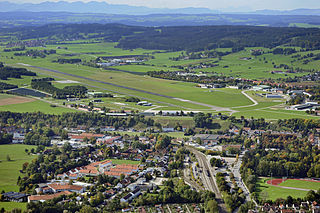
Kaufbeuren Air Base is a German Air Force military airbase. It is currently the home of the Luftwaffe Technical School 1.
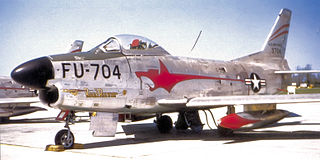
The 97th Flying Training Squadron is part of the 340th Flying Training Group and is the Reserve associate to the 80th Flying Training Wing based at Sheppard Air Force Base, Texas.
Harvey Barracks/Kitzingen Army Airfield is a former United States Army 3rd Infantry Division facility in Germany, located about 3,5 km east-northeast of Kitzingen (Bavaria), about 390 km southwest of Berlin.
Richard W. Higgins was a jet pilot with the United States Army Air Forces (USAF). A member of the 7330th Flying Training Wing in Germany, Higgins died in an aircraft accident. He is cited as one of four exemplars of bravery in the history of the German Air Force.

